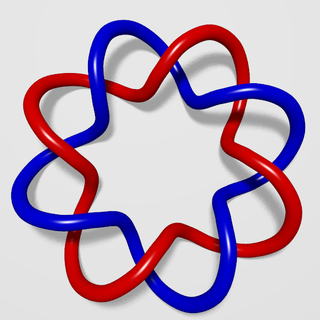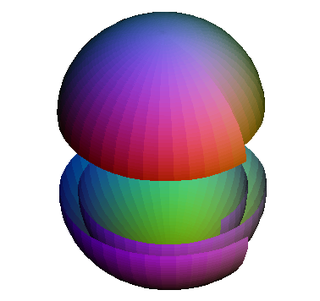
In mathematics, differential topology is the field dealing with the topological properties and smooth properties of smooth manifolds. In this sense differential topology is distinct from the closely related field of differential geometry, which concerns the geometric properties of smooth manifolds, including notions of size, distance, and rigid shape. By comparison differential topology is concerned with coarser properties, such as the number of holes in a manifold, its homotopy type, or the structure of its diffeomorphism group. Because many of these coarser properties may be captured algebraically, differential topology has strong links to algebraic topology.
In mathematics, the Pontryagin classes, named after Lev Pontryagin, are certain characteristic classes of real vector bundles. The Pontryagin classes lie in cohomology groups with degrees a multiple of four.

In mathematics, cobordism is a fundamental equivalence relation on the class of compact manifolds of the same dimension, set up using the concept of the boundary of a manifold. Two manifolds of the same dimension are cobordant if their disjoint union is the boundary of a compact manifold one dimension higher.

In mathematics, the linking number is a numerical invariant that describes the linking of two closed curves in three-dimensional space. Intuitively, the linking number represents the number of times that each curve winds around the other. In Euclidean space, the linking number is always an integer, but may be positive or negative depending on the orientation of the two curves.

In mathematics, geometric topology is the study of manifolds and maps between them, particularly embeddings of one manifold into another.
In mathematics, algebraic L-theory is the K-theory of quadratic forms; the term was coined by C. T. C. Wall, with L being used as the letter after K. Algebraic L-theory, also known as "Hermitian K-theory", is important in surgery theory.
In mathematics, in particular in algebraic topology and differential geometry, the Stiefel–Whitney classes are a set of topological invariants of a real vector bundle that describe the obstructions to constructing everywhere independent sets of sections of the vector bundle. Stiefel–Whitney classes are indexed from 0 to n, where n is the rank of the vector bundle. If the Stiefel–Whitney class of index i is nonzero, then there cannot exist everywhere linearly independent sections of the vector bundle. A nonzero nth Stiefel–Whitney class indicates that every section of the bundle must vanish at some point. A nonzero first Stiefel–Whitney class indicates that the vector bundle is not orientable. For example, the first Stiefel–Whitney class of the Möbius strip, as a line bundle over the circle, is not zero, whereas the first Stiefel–Whitney class of the trivial line bundle over the circle, , is zero.

In the mathematical field of algebraic topology, the homotopy groups of spheres describe how spheres of various dimensions can wrap around each other. They are examples of topological invariants, which reflect, in algebraic terms, the structure of spheres viewed as topological spaces, forgetting about their precise geometry. Unlike homology groups, which are also topological invariants, the homotopy groups are surprisingly complex and difficult to compute.
In an area of mathematics called differential topology, an exotic sphere is a differentiable manifold M that is homeomorphic but not diffeomorphic to the standard Euclidean n-sphere. That is, M is a sphere from the point of view of all its topological properties, but carrying a smooth structure that is not the familiar one.
In the field of topology, the signature is an integer invariant which is defined for an oriented manifold M of dimension divisible by four.

In mathematics, a manifold is a topological space that locally resembles Euclidean space near each point. More precisely, an -dimensional manifold, or -manifold for short, is a topological space with the property that each point has a neighborhood that is homeomorphic to an open subset of -dimensional Euclidean space.
In mathematics, a differentiable manifold of dimension n is called parallelizable if there exist smooth vector fields

Many branches of mathematics study objects of a given type and prove a classification theorem. A common theme is that the classification results in a number of series of objects and a finite number of exceptions — often with desirable properties — that do not fit into any series. These are known as exceptional objects. In many cases, these exceptional objects play a further and important role in the subject. Furthermore, the exceptional objects in one branch of mathematics often relate to the exceptional objects in others.
In mathematics, specifically in geometric topology, surgery theory is a collection of techniques used to produce one finite-dimensional manifold from another in a 'controlled' way, introduced by John Milnor. Milnor called this technique surgery, while Andrew Wallace called it spherical modification. The "surgery" on a differentiable manifold M of dimension , could be described as removing an imbedded sphere of dimension p from M. Originally developed for differentiable manifolds, surgery techniques also apply to piecewise linear (PL-) and topological manifolds.

In mathematics, the Arf invariant of a nonsingular quadratic form over a field of characteristic 2 was defined by Turkish mathematician Cahit Arf when he started the systematic study of quadratic forms over arbitrary fields of characteristic 2. The Arf invariant is the substitute, in characteristic 2, for the discriminant for quadratic forms in characteristic not 2. Arf used his invariant, among others, in his endeavor to classify quadratic forms in characteristic 2.
In 4-dimensional topology, a branch of mathematics, Rokhlin's theorem states that if a smooth, orientable, closed 4-manifold M has a spin structure, then the signature of its intersection form, a quadratic form on the second cohomology group , is divisible by 16. The theorem is named for Vladimir Rokhlin, who proved it in 1952.
In the mathematical area of topology, the generalized Poincaré conjecture is a statement that a manifold which is a homotopy sphere is a sphere. More precisely, one fixes a category of manifolds: topological (Top), piecewise linear (PL), or differentiable (Diff). Then the statement is
In mathematics, specifically the theory of quadratic forms, an ε-quadratic form is a generalization of quadratic forms to skew-symmetric settings and to *-rings; ε = ±1, accordingly for symmetric or skew-symmetric. They are also called -quadratic forms, particularly in the context of surgery theory.
In the mathematical surgery theory the surgery exact sequence is the main technical tool to calculate the surgery structure set of a compact manifold in dimension . The surgery structure set of a compact -dimensional manifold is a pointed set which classifies -dimensional manifolds within the homotopy type of .
In geometric topology, the de Rham invariant is a mod 2 invariant of a (4k+1)-dimensional manifold, that is, an element of – either 0 or 1. It can be thought of as the simply-connected symmetric L-group and thus analogous to the other invariants from L-theory: the signature, a 4k-dimensional invariant, and the Kervaire invariant, a (4k+2)-dimensional quadratic invariant









































